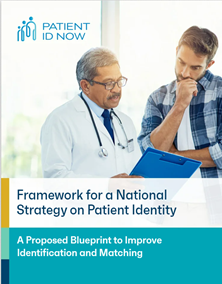

In general, every hospital system assigns its own unique identifier (known as a medical record number) to each patient whose medical record it maintains. But this makes it difficult to track patients across multiple systems and can even result in duplicate records (one patient's health information being spit into multiple records) or overlaid records (where two or more patients' health information is combined into one record).

According to an April 2021 report from the Patient ID Now coalition – which includes the American Health Information Management Association (AHIMA) – having a national strategy on patient identification and matching is needed to “support the access, exchange, and use of electronic health information.”
There are a number of challenges that occur because of the lack of a national strategy for patient identification in the United States. For example, patient privacy is compromised and quality of care and patient safety are affected.
How patient misidentification affected public health and pandemic response:
With the increased volume of COVID-19 lab results, for example, an article in the Journal of AHIMA recommends healthcare providers educate their staff about the “frequency of human error in patient identification—and how to guard against it.”
A lack of standardization of patient ID is not an issue that just affects the United States, as the World Health Organization (WHO) notes in a May 2007 report. Issues with patient ID, such as patient misidentification, can lead to prescription errors.
According to WHO, a successful patient ID plan includes the following:
An October 2018 report from Pew Trusts found around one in five patients may not be matched properly to their health information in the United States. The report also found contributing factors led to issues with patients not being matched adequately to their health information, including:

You can advocate for a national strategy on patient ID and matching to standardize information and ensure different hospitals have access to your accurate and complete medical records – a point especially important in the event of an emergency and during travel.
Contact your members of Congress to explain why they should support a national strategy on patient identification.
If you are ever unable to confirm your identification information, your healthcare provider should speak with the family member(s) you’ve designated as your “Power of Attorney for Health Care.”
According to Kaiser Permanente, you can declare a medical power of attorney by filling out relevant paperwork at a hospital, state bar association, or office on aging. The exact process varies per state.